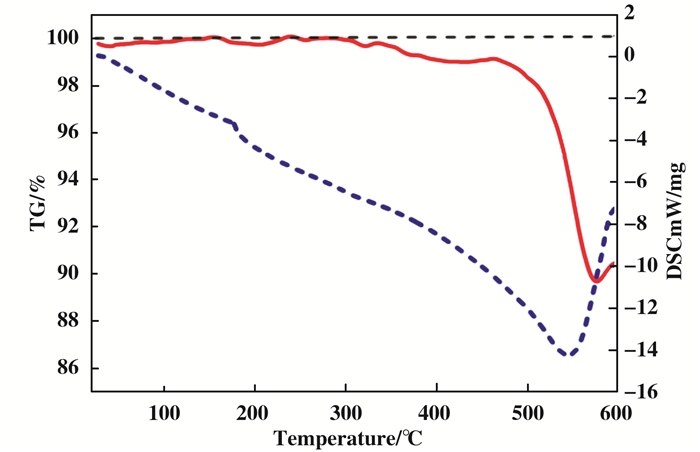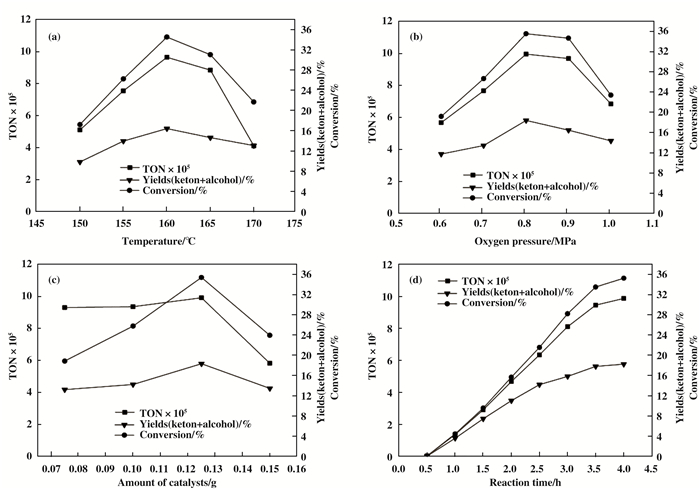细胞色素P450是生命体内一种单加氧酶[1], 其有着S—Fe轴向配位和蛋白质空腔结构, 能催化氧气将烃类氧化为醇类.目前国内外有关各种载体固载金属卟啉来模拟P450酶的结构并进行催化反应已经进行了很多研究[2-11].但是, 依然存在着很多缺陷, 比如:不耐酸, 催化效率低等不足.因此, 寻找一种既能模拟P450酶中配位和空腔功能作用调节催化活性, 又能耐酸耐高温并可重复使用的高效催化材料依然是一种挑战.
硫化银是很好的半导体材料, 但是作为载体在催化方面应用的报道很少, 而硫化锌、氧化锌、硫化镉等在这方面的研究却很多[12-16].虽然硫化锌、氧化锌、硫化镉等作为载体使用的性能很优异, 但是在催化环己烷时, 副产物环己酸的生成会溶解掉载体, 导致金属卟啉不能很好地重复利用.相比而言, 硫化银有着极小的溶度积, 很难被酸溶解, 作为载体使用, 其可重复使用性会比硫化锌、氧化锌和硫化镉的更好.
介孔硫化银拥有较高的比表面积, 其空腔结构也使得其拥有更强的吸附能力, 这使其可以作为空腔和硫配体资源.尽管有关介孔硫化银的合成方法备受关注, 比如:阳离子交换法、溶致液晶法[17].但是, 这些反应多以硫化氢气体为硫源制备介孔金属硫化物, 带来一定的环保问题.为此我们以硫代乙酰胺这种相对环保的化合物做为硫源, 合成了介孔硫化银.
我们将介孔硫化银轴向配位金属卟啉, 来模拟P450酶的轴向配位和空腔功能作用.并将其作为新型仿生催化材料, 在比较温和的反应条件下催化分子氧氧化环己烷成环己酮和环己醇.
1 实验部分 1.1 试剂5, 10, 15, 20-四(4-吡啶基)卟啉(H2TPyP, 97%)购于迈瑞尔; 聚氧乙烯10油醚(BRIJO10, 99%)、硝酸银(AgNO3, 98%)、硫代乙酰胺(MPTMS, 95%)和环己烷(99.7%)购于阿拉丁; 其余试剂均为分析纯, 购于西陇科学股份有限公司.
1.2 介孔硫化银的制备将0.169 87 g AgNO3粉末溶于25 mL 0.01 mol/L HNO3溶液中, 制备成25 mL 0.04 mol/L的硝酸银(AgNO3)酸溶液.在室温条件下, 将其与等体积的聚氧乙烯10油醚(BRIJO10)1:1滴加混合, 放入冰箱保存.然后加入硫代乙酰胺(TAA)粉末搅拌2 min, 将反应器密封24 h后, 过滤, 再用乙醇盐酸溶液洗涤固体多次, 在-50 ℃下真空冷冻干燥6 h, 获得介孔硫化银.
1.3 5, 10, 15, 20-四(4-吡啶基)锰卟啉的制备5, 10, 15, 20-四(4-吡啶基)锰卟啉(Mn TPyP)的合成[18]:将0.050 g H2 TPyP溶解在40 mL DMF中, 并将混合物加热至回流, 缓慢加入0.800 g MnCl2·6H2O.继续回流4.5 h, 然后冷却至环境温度.过滤除去不溶于常温DMF的H2TPyP和MnO2, 收集滤液, 旋蒸得到墨绿色固体, 并用150 mL去离子水稀释, 加入0.2 g NaCl将Mn TPyP重结晶出来, 过滤, 干燥获得锰卟啉.
制备介孔硫化银固载5, 10, 15, 20-四(4-吡啶基)锰卟啉:将Mn TPyP溶解到去离子水中, 配制成一份100 mg/LMn TPyP的溶液.称取0.5 g介孔硫化银超声分散在400 mL去离子水中, 再将20 mL的Mn TPyP溶液加到该悬浊液中, 在50 ℃下搅拌12 h, 过滤, 用去离子水洗涤, 在85 ℃将所得固载物干燥24 h, 得Mn TPyP/mp-Ag2S纳米孔催化材料.通过ICP技术测定锰卟啉的固载量为3.98 mg/g.催化剂的制备流程如图所示:

|
图示1 mp-Ag2S和固定化Mn TPyP/mp-Ag2S制备过程 Scheme 1 The process of preparing mp-Ag2S and immobilized Mn TPyP on mp-Ag2S |
使用TU-1810SPC光谱仪记录紫外-可见光谱.使用TriStar II 3flex型分析仪于77 K下的液氮浴中测试N2吸附/脱附等温线并通过BET法及BJH法计算催化材料比表面积和孔径分布.用FEI Tecnai G2 F20型透射电子显微镜观察催化材料微观形貌, 加速电压为200 kV.对于ICP-OES, 将约0.05 g催化材料通过HNO3消解浸出, 再添加蒸馏水将最终体积补足至25 mL.使用Netzsch TG 209 F3型热重分析仪, 在空气气氛中, 升温速率10 ℃/min条件下对样品进行热重分析.用配备有Al Ka微聚焦单色器, 可变光斑尺寸为30~400 μm的K-Alpha+型X射线光电子能谱仪对催化材料的表面化学成分及关键元素结合能进行分析.
1.5 5, 10, 15, 20-四(4-吡啶基)锰卟啉氧化环己烷将200 mL环己烷和一定量的Mn TPyP/mp-Ag2S投入300 mL压力搅拌反应釜中, 搅拌并加热至反应温度后, 持续通入氧气并调节釜内压力至反应所需压力.控制搅拌速度220 r/min, 尾气流量0.03 m3/h.反应开始后, 每30 min从取样口处取釜底溶液一次, 样品经气相色谱(GC)鉴定, 用天美GC-7900色谱仪、25 m×0.25 mm×0.5 μm PEG-20M毛细管柱和火焰离子化检测器(进样口和检测器设定温度为180 ℃, 柱温120 ℃), 以氯苯为内标物定量测定环己酮和环己醇的含量.以酚酞为指示剂, 用酸碱滴定法测定酸和酯的含量.将釜内反应混合液过滤, 并用乙醇洗涤, 回收催化材料, 85 ℃烘干, 用于下一次催化. Mn TPyP/mp-Ag2S催化环己烷氧化反应如下:

|
图示2 Mn TPyP/mp-Ag2S催化氧化环己烷 Scheme 2 Cyclohexane oxidation catalyzed by Mn TPyP/mp-Ag2S |
从图 1(a)看到实验制备的载体材料为纳米多孔材料, 而从图 1(b)看到固载金属卟啉后, 孔径明显变小, 这可能是由于直径为2 nm左右卟啉分子[19]填补了那些较大的孔洞.

|
图 1 mp-Ag2S(a)和Mn TPyP/mp-Ag2S(b)的透射电镜图和mp-Ag2S(c)和Mn TPyP/mp-Ag2S(d)在-196 ℃的氮气吸附等温线及孔径分布图 Fig.1 TEM images of mp-Ag2S(a) and Mn TPyP/mp-Ag2S(b), Nitrogen adsorption and desorption isotherms at -196 ℃ and pore size distribution for mp-Ag2S(c) and Mn TPyP/mp-Ag2S(d) |
mp-Ag2S和Mn TPyP/mp-Ag2S的N2吸脱-解吸测量结果分别由图 1(c、d)所示.样品表现为H1型迟滞回线, 属于Ⅳ型等温线, 这是介孔固体中的典型曲线[20], 具体数据由表 1列出.通过孔径分析可以看出, 固载金属卟啉后, 孔径分布由3.8下降到1.7 nm, 这很可能是因为卟啉分子填充到了直径大于2 nm的孔洞中, 造成了平均孔径、孔体积和比表面的下降.这与TEM表征结果相符.
| 表 1 mp-Ag2S和Mn TPyP/mp-Ag2S材料的结构特性 Table 1 Structural characteristics of mp-Ag2S and Mn TPyP/mp-Ag2S |
图 2(a)为催化材料的紫外-可见吸收光谱.当H2 TPyP与MnCl2·6H2O反应后, 产生Mn TPyP, Soret带从439变为462 nm, 且Q带516、589和635 nm消失, 出现新的峰560 nm.与文献[21]报道基本一致, 这说明Mn TPyP已有效合成.将Mn TPyP固载在mp-Ag2S上后, 其Soret带在Mn TPyP/mp-Ag2S中红移至467 nm.这说明Mn TPyP已经通过配位作用固载到了mp-Ag2S上[22-23]. 图 2(b)显示的拉曼光谱曲线可知, 锰卟啉在376 cm-1处有Mn-Cl共价键的峰[24], 硫化银在250~500 cm-1处没有峰, 而Mn TPyP/mp-Ag2S在369 cm-1处有Mn(Ⅲ)-S峰[25-26].这也说明Mn TPyP已经由S-Mn配位作用固载到了mp-Ag2S上.

|
图 2 H2TPyP, Mn TPyP和Mn TPyP/mp-Ag2S的紫外光谱图和mp-Ag2S, Mn TPyP和Mn TPyP/mp-Ag2S(b)的拉曼光谱图 Fig.2 UV spectra for H2TPyP, Mn TPyP and Mn TPyP/mp-Ag2S and Raman spectra for mp-Ag2S, Mn TPyP and Mn TPyP/mp-Ag2S (b) |
Mn TPyP和Mn TPyP/ mp-Ag2S的关键元素(Mn, N, Cl和S)的X射线光电子测试结果如图 3和表 2所示. Mn TPyP的XPS测量光谱中的关键元素(Mn, N, Cl和S)存在于Mn TPyP/mp-Ag2S的相应光谱中.这表明Mn TPyP已经固载在mp-Ag2S上.由于mp-Ag2S中硫原子与Mn TPyP中锰离子的配位导致硫的结合能从161.13和162.30 eV[27-28]分别增高到161.85和163.14 eV, 即相应的ΔBE值为0.72和0.84, 表明:硫原子将其孤对电子配给了锰离子.同时, 这可能使得Mn TPyP中关键元素(Mn, N和Cl)的结合能发生变化.氯的结合能从197.08和198.73[29]降到196.52和198.02 eV, 导致氯离子的电子云密度增高.这导致锰的正电性增强(MnⅢ 2p3/2和MnⅢ 2p1/2[30], ΔBE分别为0.62和0.26 eV).这可以使氧分子更容易接近催化剂的活性中心锰离子并活化, 有利于催化氧化反应.另外, 与锰离子配位的氮原子的结合能从400.01[31]增加到400.13 eV, 这说明了氮与锰的配位作用在固载之后更加强, 提高了催化剂的稳定性.总之, 这些效应导致锰离子携带更多的正电荷, 比固载前更容易结合和活化氧分子; 锰离子更加稳定不易脱落.

|
图 3 催化材料的XPS谱图 Fig.3 XPS spectra of catalytic materials |
| 表 2 Mn TPyP、Mn TPyP和Mn TPyP/mp-Ag2S的关键元素结合能 Table 2 Binding energies for the key element of Mn TPyP、Mn TPyP and Mn TPyP/mp-Ag2S |
图 4显示Mn TPyP/mp-Ag2S的热重分析曲线, 300 ℃以下几乎无失重, 而本催化实验的最高温度为170 ℃, 这意味着在催化实验中, 催化剂具有很高的热稳定性.

|
图 4 Mn TPyP/mp-Ag2S热重、热流曲线 Fig.4 TG and DSC curves of Mn TPyP/mp-Ag2S |
图 5(a)中显示的是环己烷在氧气压力为0.9 MPa、催化剂Mn TPyP/mp-Ag2S用量为0.125 g, 反应时间为4 h时, 不同的温度条件下环己烷转化率、转化数和主要产物产率(环己酮和环己醇)的影响.显然, 160 ℃是催化材料的较适宜氧化反应温度, 可以发挥其最大催化性能. 图 5(b)是在160 ℃下不同压力对催化剂性能的影响, 最佳氧气压力为0.8 MPa.这可能是因为在更大的氧气压力条件下, 高浓度的氧气会氧化一部分固载在mp-Ag2S上的金属卟啉以使其失活[32-33]. 图 5(c)是不同的催化剂用量对催化反应的影响, 可以看出0.125 g的催化剂用量已经达到了最好的催化效果, 继续增加催化剂用量反而会使催化反应效果变差, 这可能是一种催化剂抑制现象[34-35].为了探索最好的催化反应时间, 从图 5(d)可以看出在催化反应到4 h时, 环己烷的转化率和转化数以及醇酮产率已经达到最高, 这意味着若反应继续进行, 转化率和醇酮产率不会有显著提高.反而, 在高温高压下金属卟啉会导致破坏而且副产物己二酸和己二酸二环己酯会大量增加.因此, Mn TPyP/mp-Ag2S的最好反应条件为:反应温度160 ℃、氧气压力为0.8 MPa、催化剂用量0.125 g和反应时间为4 h.

|
图 5 在不同反应温度(a)、氧气压力(b)、催化剂用量(c)和反应时间(d)下, 固载金属卟啉催化氧化环己烷的转化率和转化数及醇酮产率随反应条件的变化 Fig.5 Changes in the conversion rate, turn over number and yields with reaction temperature, pressure, time an dosages of catalyst for the first run in oxygen oxidation of cyclohexane over the supported catalysts |
从表 3中可以看出:与Mn TPyP相比, Mn TPyP/mp-Ag2S催化环己烷的转化率和产率分别提高了46.9%和29.6%.更重要的是直接使用金属卟啉作为催化剂催化环己烷会因为催化剂氧化失活而无法重复使用.但是, Mn TPyP/mp-Ag2S具有良好的可重复催化使用性能.如表 3所示, 在多次使用后催化材料的性能没有明显的下降(考虑到每次回收催化剂的损失后).总之, 本催化材料具有更强的催化活性和重复使用性.
| 表 3 最佳条件下, 两种催化剂的催化性能对比 Table 3 Comparison of catalytic performance of Mn TPyP/mp-Ag2S with that of Mn TPyP under optimal reaction conditions |
我们采用了硫代乙酰胺做为硫源, 以溶致结晶法合成了介孔硫化银, 改进了以往直接使用H2S气体所带来的环保问题.为了模拟细胞色素P450酶的轴向配位和纳米空腔结构, 以轴向配位的方式将金属卟啉Mn TPyP固载到具有介孔结构的Ag2S上, 并用于催化环己烷氧化.
从分子结构上来看, 将Mn TPyP通过轴向配位作用固载到介孔硫化银上. Mn离子的正电性提高, 有利于对氧分子的活化, 这使得催化活性比未固载的Mn TPyP大幅度提高.而且由于Mn TPyP被嵌入介孔中, 使得Mn TPyP更难脱落, 提高了催化剂的稳定性, 这使得锰卟啉使用5次之后, 依然有着很好的催化性能.
这为Mn TPyP提供了高效、经济而且环保地用于催化分子氧氧化环己烷制备环己酮和环己醇的方法.
| [1] |
Braun P V, Osenar P, Tohver V, et al. Nanostructure templating in inorganics olids with organic lyotropic liquid crystals[J]. J Am Chem Soc, 1999, 121(32): 7302–7309.
DOI:10.1021/ja9833725 |
| [2] |
a. She Yuan-bin (余远斌), Sun Zhi-cheng (孙志成). Research progress and prospect for porphyrin and metalloporphyrin compounds(卟啉及金属卟啉类化合物的研究进展及展望)[J]. Chem Reag(化学试剂), 2011, 33(9): 769-772. b. Liu Wen-fang(刘文芳), Wei Li-na(魏利娜). Research progress on carbonic anhydrase immobilization(碳酸酐酶固定化研究进展)[J]. J Mol Catal(China)(分子催化), 2016, 30(2): 182-197. c. Hua Shao-feng(华绍烽), Fan Yun-chang(范云场), Zhang Lei(张磊), et al. Reconstitution of an active methane monooxygenase complex from the recombination subunits in vitro(甲烷单加氧酶活性化合物的体外重构)[J]. J Mol Catal(China)(分子催化), 2016, 30(6): 594-598.
|
| [3] |
Feng Ze(冯泽), Xie Yu-jia(颉雨佳), Hao Fang(郝芳), et al. The catalytic performance of cobalt tetra(4-nitrophonyl) metalloporphyrin supported on zinc oxide in cyclohexane oxidation(氧化锌负载四(4-硝基苯基)锰卟啉催化氧化环己烷性能)[J]. J Mol Catal(China)(分子催化), 2016, 30(1): 20–28.
|
| [4] |
Zarrinjahan A, Moghadam M, Mirkhani V, et al. Graphene oxide nanosheets supported manganese(Ⅲ) porphyrin: a highly efficient and reusable biomimetic catalyst for epoxidation of alkenes with sodium periodate[J]. J Iran Chem Soc, 2016, 13(8): 1509–1516.
DOI:10.1007/s13738-016-0867-1 |
| [5] |
Bolzon L B, Airoldi H R, Zanardi F B, et al. Metalloporphyrin-functionalized hexagonal mesoporous silica: Synthesis, structural properties and catalytic activity as cytochrome P450 model[J]. Micro & Mes Mater, 2013, 168(3): 37–45.
|
| [6] |
Machado G S, Wypych F, Nakagaki S. Immobilization of metalloporphyrins into nanotubes of natural halloysite toward selective catalysts for oxidation reactions[J]. J Mol Catal A Chem, 2008, 283(1/2): 99–107.
|
| [7] |
Machado G S, Ucoski G M, Lima O J D, et al. Cationic and anionic metalloporphyrins simultaneously immobilized onto raw halloysite nanoscrolls catalyze oxidation reactions[J]. Appl Catal A Gen, 2013, 460(11): 124–131.
|
| [8] |
Zhu Q, Maeno S, Sasaki M, et al. Monopersulfate oxidation of 2, 4, 6-tribromophenol using an iron(Ⅲ)-tetrakis(p -sulfonatephenyl)porphyrin catalyst supported on an ionic liquid functionalized Fe3O4, coated with silica[J]. Appl Catal B Environ, 2015, 163: 459–466.
DOI:10.1016/j.apcatb.2014.08.035 |
| [9] |
Niu Jin-fen(钮金芬), Yao Bing-hua(姚秉华), Liu Ting-ting(刘婷婷). Preparation and photocatalytic acti-vity study of meso-tetrakis(4-hydroxylphenyl) porphyrin(MTHPP)/TiO2 composites(四羟基苯基金属卟啉(MTHPP)/TiO2的合成及其光催化活性的研究)[J]. J Mol Catal(China)(分子催化), 2011, 25(5): 435–441.
|
| [10] |
Wang Qi-ying(王琪莹), Liu Zi-li(刘自力), Zou Han-bo(邹汉波), et al. Progress in metalloporphyins immobilized on silica series in heterogeneous biomimetic cata-lysis processes(氧化硅基固载金属卟啉多相仿生催化剂研究进展)[J]. J Func Mater(功能材料), 2017, 48(2): 2041–2047.
|
| [11] |
Huang G, Guo Y A, Zhou H, et al. Oxidation of cyclohexane with a new catalyst (TPPFeⅢ)2O supported on chitosan[J]. J Mol Catal A Chem, 2007, 273(1): 144–148.
|
| [12] |
Huang X F, Yuan G P, Huang G, et al. Study on maximizing catalytic performance of cobalt (Ⅱ) 5, 10, 15, 20-tetrakis (4-pyridyl) porphyrin for cyclohexane oxidation[J]. J Ind Eng Chem, 2019, 77: 135–145.
DOI:10.1016/j.jiec.2019.04.028 |
| [13] |
Chandrasekaran S, Misra R D K. Photonic antioxidant ZnS (Cd) nanorod synthesis for drug carrier and bioimaging[J]. Mater Technol, 2013, 28(4): 228–233.
DOI:10.1179/1753555713Y.0000000084 |
| [14] |
Che Pei-zhi(车丕智). Studies on Synthesis and catalytic activity of new polymer supported chelated titanate(新型固载化螯合钛酸酯的合成及催化酯化性能的研究)[J]. J Mol Catal(China)(分子催化), 1998, 12(2): 148–151.
|
| [15] |
Zhang Jin-chang(张金昌), Wang Yan-hui(王艳辉), Ma Run-yu(马润宇), et al. Selective catalytic oxidation of CO in rich hydrogen over gold-platinum supported on zinc oxide for potential application in fuel cell(氧化锌负载金和铂选择催化氧化燃料电池氢源中微量CO的研究)[J]. J Beijing Univer Chem Technol(Nat Sci Edit)(北京化工大学学报(自然科学版)), 2003, 31(1): 1–4.
DOI:10.3969/j.issn.1671-4628.2003.01.001 |
| [16] |
Yan Z, Sun Z, Liu X, et al. Cadmium sulfide/graphitic carbon nitride heterostructure nanowire loading with anickel hydroxide cocataly stfor highly efficient photocatalytic hydrogen production in water under visible light[J]. Nanoscale, 2016, 8(8): 4748–4756.
DOI:10.1039/C6NR00160B |
| [17] |
a. Wang J, Xu W, Bao H, et al. Synthesis of ordered mesoporous crystalline CuS and Ag2S material sviacation exchange reaction[J]. Nanoscale, 2015, 7(10): 4468-4474. b. Braun P V, Osenar P, Tohver V, et al. Nanostructure templating in inorganic solids with organic lyotropic liquid crystals[J]. J Am Chem Soc, 1999, 121(32): 7302-7309. |
| [18] |
Takahashi K, Komura T, Imanaga H. Light-induced redox characteristics of [tetrakis (4-methylpyridyl) porphyrinato] manganese[J]. Bull Chem Soc Japan, 1983, 56(11): 3203–3207.
DOI:10.1246/bcsj.56.3203 |
| [19] |
Boeckl M S, Bramblett A L, Hauch K D, et al. Self-assembly of tetraphenylporphyrin monolayers on gold substrates[J]. Langmuir, 2000, 16(13): 5644–5653.
DOI:10.1021/la991513q |
| [20] |
Lin Q, Li Y, Yang M. Tin oxide/graphene composite fabricated via a hydrothermal method for gas sensors working at room temperature[J]. Sens & Actua B Chem, 2012, 173(10): 139–147.
|
| [21] |
Połtowicz J, Serwicka E M, Bastardo-Gonzalez E, et al. Oxidation of cyclohexene over Mn (TMPyP) porphyrin-exchanged Al, Si-mesoporous molecular sieves[J]. Appl Catal A: Gen, 2001, 218(1/2): 211–217.
|
| [22] |
Wang Pei(王培), Huang Guan(黄冠), Liu Yao(刘垚), et al. Catalytic oxidation of cyclohexane by lead sulfide supported tetrafluorophenyl manganese porphyrin(硫化铅固载四(五氟苯基)锰卟啉催化氧化环己烷)[J]. J Guangxi Univer (Nat Sci Edit)(广西大学学报(自然科学版)), 2017, 42(5): 1835–1842.
|
| [23] |
Liu Yao(刘垚), Huang Guan(黄冠), Guo Wen-xin(国文馨), et al. Catalytic oxidation of cyclohexane by cadmium sulfide supported tetra (4-carboxyphenyl) manganese porphyrin(硫化镉固载四(4-羧基苯基)锰卟啉催化氧化环己烷)[J]. J Guangxi Univer(Nat Sci Edit)(广西大学学报(自然科学版)), 2017, 42(6): 2264–2273.
|
| [24] |
Asher S, Sauer K. Resonance raman spectroscopy of Mn (Ⅲ) etioporphyrin Iatthe π→π* and charge transfer bands: The use of charge transfer bands tomonitor the complexation state of metalloporphyrins[J]. J Chem Phys, 1976, 64(10): 4115–4125.
DOI:10.1063/1.431979 |
| [25] |
Kawabe H, Sugiura Y, Tanaka H. Environment of Mn (Ⅲ) and its function in a red-violet colored acid phosphatase[J]. Inorg Chim Acta, 1983, 79: 112–113.
DOI:10.1016/S0020-1693(00)95144-2 |
| [26] |
Sugiura Y, Kawabe H, Tanaka H, et al. First evidence for manganese binding to sulfur donor group in metalloprotein, manganese (Ⅲ)-containing acid phosphatase[J]. J Am Chem Soc, 1981, 103(4): 963–964.
DOI:10.1021/ja00394a052 |
| [27] |
Chowdari B V R, Mok K F, Xie J M, et al. Spectroscopic and electrical studies of silver sulfophosphate glasses[J]. J Non-Cry Sol, 1993, 160(1/2): 73–81.
|
| [28] |
Wang T X, Chen W W. Low-temperature synthesis of purerock-salt structure manganese sulfide using asingle-source molecular precursor[J]. Chem Eng J, 2008, 144(1): 146–148.
DOI:10.1016/j.cej.2008.03.017 |
| [29] |
Yoshida T, Yamasaki K, Sawada S. An X-ray photo electron spectroscopic study of biuret metal complexes[J]. Bull Chem Soc Japan, 1978, 51(5): 1561–1562.
DOI:10.1246/bcsj.51.1561 |
| [30] |
Fu L, Lu Y, Liu Z, et al. Influence of the metal sites of MNC (M = Co, Fe, Mn) catalysts derived from metalloporphyrins in ethyl benzene oxidation[J]. Chin J Catal, 2016, 37(3): 398–404.
DOI:10.1016/S1872-2067(15)61029-4 |
| [31] |
Wu Z Y, Xu S L, Yan Q Q, et al. Transitionmetal-assisted carbonization of small organic molecules toward functional carbonmaterials[J]. Sci Adv, 2018, 4(7): eaat0788.
DOI:10.1126/sciadv.aat0788 |
| [32] |
Huang G, Mo L Q, Cai J L, et al. Environmentally friendly and efficient catalysis of cyclohexane oxidation by iron meso-tetrakis(pentafluorophenyl)porphyrin immobilized on zinc oxide[J]. Appl Catal B Environ, 2015, 162(10): 364–371.
|
| [33] |
Huang G, Liu Y, Cai J L, et al. Heterogeneous biomimetic catalysis using ironporphyrin for cyclohexane oxidation promoted by chitosan[J]. Appl Surf Sci, 2017, 402: 436–443.
DOI:10.1016/j.apsusc.2017.01.082 |
| [34] |
Black J F. Chem Inform Abstract: metal-catalyzed autoxidation[J]. Chem Inform, 1978, 9(18): 527–535.
|
| [35] |
Guo C C, Liu Q, Wang X T, et al. Selective liquid phase oxidation of toluene with air[J]. Appl Catal A Gen, 2005, 282(1): 55–59.
|
 2019, Vol. 33
2019, Vol. 33


